
About UsThe Numismatic Bibliomania Society is a non-profit organization promoting numismatic literature. For more information please see our web site at coinbooks.org SubscriptionsThose wishing to become new E-Sylum subscribers (or wishing to Unsubscribe) can go to the following web page link MembershipThere is a membership application available on the web site Membership Application To join, print the application and return it with your check to the address printed on the application. Membership is only $15 to addresses in the U.S., $20 for First Class mail, and $25 elsewhere. For those without web access, write to: David M. Sundman, Secretary/TreasurerNumismatic Bibliomania
Society AsylumFor Asylum mailing address changes and other membership questions, contact David at this email address: dsundman@LittletonCoin.com SubmissionsTo submit items for publication in The E-Sylum, just Reply to this message, or write to the Editor at this address: whomren@coinlibrary.com
BUY THE BOOK BEFORE THE COINYou won't regret it! |
- WAYNE'S WORDS: THE E-SYLUM MARCH 4, 2012
- LAKE BOOKS 110TH MAIL-BID SALE CLOSES MARCH 6, 2012
- NEW BOOK: 2013 WORLD PAPER MONEY, MODERN ISSUES 1961-PRESENT
- NEW BOOK: ANATOLIAN CITIES AND THEIR COINS
- JOHN REICH JOURNAL INDEX AVAILABLE
- CENTRAL STATES NUMISMATIC SOCIETY ANNOUNCES AUTHOR GRANTS
- THAI NUMISMATIST LEE SHIN SONG
- QUIZ ANSWER: ROBERT COULTON DAVIS
- REVIEW: CAPPING LIBERTY EXHIBITION WEB SITE
- NOTES FROM E-SYLUM READERS: MARCH 4, 2012
- QUERY: WHY AREN'T COMMEMORATIVE COIN SURCHARGES TAX-DEDUCTIBLE?
- 1937 INTERNATIONAL EXHIBITION OF ARTS AND TECHNOLOGY MEDAL
- THE NEW YORK NUMISMATIC SCENE IN THE 1930S
- THE MINT AT THE MESCAL MINE: COUNTERFEITING U.S. COINS
- CONTEMPORARY COUNTERFEITS OF SEATED LIBERTY COINAGE
- ARTICLE EXPLORES THREAT OF DOLLAR COIN COUNTERFEITING
- A LIBERTY SEATED QUARTER COIN GLASS SAUCE DISH
- FLEA MARKET FIND STORY: CONTINENTAL DOLLAR IN PEWTER
- THE COLLECTION OF W.W.C. WILSON
- TEDXLEEDS2012: ALTERNATIVE MONEY CONFERENCE
- BANK OF ENGLAND'S LOW-SERIAL NUMBER BANKNOTES
- THE 1933 DOUBLE EAGLE WORLD TOUR OPENS IN LONDON
- LIBERIA'S DUAL CURRENCY SITUATION
- 'STAR-SPANGLED BANNER' COINS IN CHOCOLATE
- FEATURED WEB PAGE: COINING TECHNOLOGY HERITAGE
WAYNE'S WORDS: THE E-SYLUM MARCH 4, 2012

New members this week include Tom Casper and James Gill. Welcome aboard! We have 1,516 email subscribers, plus 174 followers on Facebook.
This issue is coming to you a day early, courtesy of your editor's Sunday travel.
This week we open with a note from Fred Lake, information on two new numismatic books, an index, and the CSNS author grants.
Other topics include Robert Coulton Davis, W.W.C. Wilson, the Capping Liberty exhibit, counterfeiting U.S. coins, alternative currency and the world tour of a 1933 Double Eagle.
To learn more about Thai numismatist Lee Shin Song, Hi Steinberg, Tom Elder's Super-Vegetables, Art Deco medals, the Mint at the Mescal mine, and where the Bank of England's low serial number notes go, read on. Have a great week, everyone!
Wayne Homren
(whomren@gmail.com)
Numismatic Bibliomania Society
LAKE BOOKS 110TH MAIL-BID SALE CLOSES MARCH 6, 2012
This is to remind you that Lake Books' 110th mail-bid sale of numismatic literature closes on Tuesday March 6, 2012 at 5:00 PM (EST). The 482-lot sale features selections from the library of John R. (J.R.) Frankenfield who was a driving force in the Early American Coppers realm. Other consignors have contributed material that fills out the offerings to include reference works on Ancient Coinage, World Coinage, Paper Money, Tokens & Medals, Exonumia and some miscellaneous pieces. You may view the entire sale on our web site at http://www.lakebooks.com/current.html and you may place your bids via email, fax or telephone until the closing time. Good Luck with your bidding !
Lake Books
6822 22nd Ave. N.
St. Petersburg, FL 33710
727-343-8055 Fax 727-345-3750
NEW BOOK: 2013 WORLD PAPER MONEY, MODERN ISSUES 1961-PRESENT
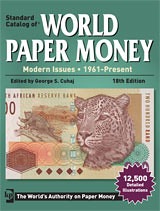 The new edition of the Standard Catalog of World Paper Money, Modern Issues 1961-present, is now available from Krause Publications.
The new edition of the Standard Catalog of World Paper Money, Modern Issues 1961-present, is now available from Krause Publications.
Edited by George Cuhaj, the 18th edition of this indispensable reference includes:
-19,750 variety listings of world bank notes.
-12,750 illustrated bank notes for easy identification.
--Current retail prices in two grades of condition.
--Country signature charts for specific variety identification.
A network of more than 80 international paper money collectors and dealers work with Cuhaj to ensure that the Standard Catalog is the most comprehensive resource available for the proper identification, description and valuation of modern world bank notes.
For more information visit:
www.shopnumismaster.com/product/2013-standard-catalog
-of-world-paper-money-modern-issues-w7376/world-paper-money
NEW BOOK: ANATOLIAN CITIES AND THEIR COINS
 Anatolian Cities and Their Coins Through History
Anatolian Cities and Their Coins Through History
The book was conceived as part of a project to present an outline of the social and cultural panorama of Anatolia and Turkish Thrace throughout history. The book is made up of cities and coins, presenting a selection of the coins minted in the cities of Anatolia and Turkish Thrace from the invention of coinage through to the founding of the Republic of Turkey. In preparing this selection, the whole of this 2,600-year continuing tradition of coinage, with all its numerous turning points, has been taken into account. Coins are not and never were, simply a means of payment: through the words and images pressed into their metal; they have always been documents highly reflective of the political, social, cultural, and religious life of their period, and with this book you will have the great opportunity to read the history of Anatolia and Turkish Thrace as it is expressed on coins.
- Talking Coins - Anatolian Cities and Their Coins Through History / Konusan Paralar - Tarih Boyunca Anadolu Kentleri ve Sikkeleri
- Author: Tekin, Oguz
- Publisher: Türkiye Is Bankasi Kultur Yayinlari
- ISBN: 9786053604402
- Publication Date & Place: 2012, Ýstanbul
- Dimensions: 270x315mm, 3000 gr.
- Price: 65,00 € (Direct Delivery)
For more information or to order, see:
www.zerobooksonline.com/eng/product_details.asp?
cat=&subcat=&product=6714
JOHN REICH JOURNAL INDEX AVAILABLE
In the 26 February 2012 issue of the JR Newsletter, an electronic publication of the John Reich Collector's Society, Brad Karoleff wrote:
Today, I shipped the index to John Reich Journal volumes one through twenty. The index was not funded by dues payments, instead it was paid for by fundraisers and donations.
Brad writes:
We will sell the index to non-members for $15 delivered which may be credited towards membership of $25/year if they join. We do not have bound volumes like LSCC. The index can be ordered from me at bkaroleff@yahoo.com or by mail at JRCS C/O Brad Karoleff 225 E 6th St. suite 1 Cincinnati, OH 45202.
CENTRAL STATES NUMISMATIC SOCIETY ANNOUNCES AUTHOR GRANTS
Central States Numismatic Society Governor (and NBS webmaster) Bruce Perdue writes:
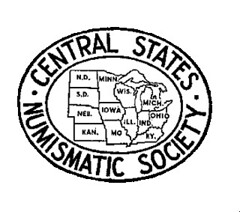 I thought that the readers of The E-Sylum might find the following of great interest.
I thought that the readers of The E-Sylum might find the following of great interest.
Ray Lockwood, education Director of Central States mentions in his quarterly column in "The Centinel" the following:
"In October, the Central States Board authorized $20,000 for grants of up to $5,000 for authors of numismatic books and/or video productions. To date, the total budget has been awarded to the following authors:
$5,000 to Robert Julian of Logansport, IN, to conduct research on a book covering the United States Mint from 1792 to 1837;
$5,000 to Neil Shafer of Milwaukee to complete work on a book titled: A Catalog of Panic Scrip of 1893, 1907 & 1914;
$5,000 to Fred Reed of Carrollton, TX, for research on a new book titled: Civil War Stamp Envelopes, the Issuers and Their Times
$4,000 to Dr. John Amato of Dallas, to finish work on his book, The Draped Bust Half Dollars of 1796-1797: Numismatic Background and Census; and
$1,000 to Harry Waterson of Branson, MO, to finish work on his book; The Medal of the Month Club. "
As a member of the Education Committee which formulated this program and as a current board member and hopefully the next Vice President of Central States, I am pleased with the awards Central States has made and will be recommending that we expand the program in the future.
For more information on CSNS, see: www.centralstates.info
THAI NUMISMATIST LEE SHIN SONG
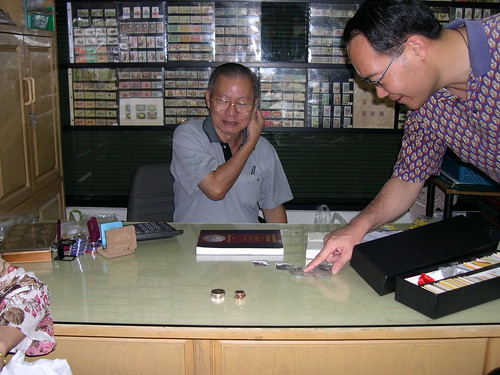
I received an email from Ronachai Krisadaolarn Thursday morning, March 1, that Mr. Lee (Lee Shin Song) had passed today in Bangkok. He had been fighting liver cancer for at least a year and I thought he had conquered it until I started receiving emails a few weeks ago that he was going back in and out of a hospital for treatments. Mr. Lee will be greatly missed by numismatists worldwide and he is a great loss to Thai numismatics.
I first met him sometime in the mid-1960s when I was in Bangkok working on a back-up site for my intelligence unit's magnetic tapes from Viet Nam. I quickly found a home for them in the JUSMAG (Joint Military United States Military Assistance Group) Compound and then I had a couple of days to wander around Bangkok. My first action in a new city is to look in the Yellow Pages for coin and stamp businesses. I eventually walked into the Lee Kim Guan (his father's name) store on Silom Road. One wall was completely covered from floor to ceiling with shelves full of Southeast Asian paper money in bricks and packs! It was an impressive sight! I sat down at a counter and was shown coins, tokens and paper money for sale. There were also philatelic items, books and antiques. It took a couple of years for him and the staff to consider me a serious collector of Thai numismatic pieces. After that, I was shown and offered the really good stuff.
When I was in the shop for the last time during the Vietnam War in late 1972, I told Mr. Lee that I would bring back my Thai collection when I no longer needed or wanted it. I did bring back my paper money collection a few years ago and then my coin and token collection. The image of Mr. Lee shows him at a desk with the boxes of my coin and token collection that I just delivered, and a Thai collector, Arthasith Katanyutanon, already looking through it to tell Mr. Lee which pieces he would like to purchase. I was told many collectors came to the store to see each collection and they were completely sold in about ten days.
Whenever I was in his store, he always invited me and other serious collectors and dealers into his office. He would have stacks, boxes and albums of pieces all over the place. It was always a thrill for me to "dig" through it and find something for my one of my collections. I would also find pieces in his case in the lobby, especially old Burmese Mon lead/tin/copper coins which I bought in quantity to find varieties.
His son, Kris Sukonritikorn, will hopefully and likely direct the business. It is located at 1142 Charoenbrung Road (the old New Road near the General Post Office), Bangkok 10501.
I am really sad for Mr. Lee's family because it is plain to see they are very close and loved each other. My trips to Bangkok will never be the same without Mr. Lee.
THE BOOK BAZARRE
QUIZ ANSWER: ROBERT COULTON DAVIS
Last week Pete Smith wrote:
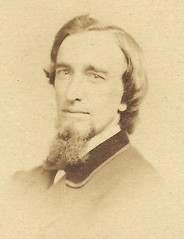 Attached, for your consideration, is the photo of a mystery numismatist.
I offer two clues to his identity:
Attached, for your consideration, is the photo of a mystery numismatist.
I offer two clues to his identity:
1. The date 1864 is written in pencil on the back of the print.
2. His name appears in Consecutive Issue 87 of The Asylum.
I will provide the identity next week along with a follow-up question.
Mike Packard writes:
The picture in Pete Smith's question looks like Augustus Sage.
David Gladfelter writes:
Just a guess: William Frederick Mayers? He's not in Smith's American Numismatic Biographies (1992). (Maybe it's time for a second edition?) In the meantime, you can read all about Mayers in Pete's article in The Asylum, Summer 2004, page 162.
My guess was Sage, but we're all wrong. Pete Smith writes:
The "mystery numismatist" shown last week is Robert Coulton Davis (1813-1888). While the identification may have been a difficult challenge, it was not impossible.
E. L. Mason published his Mason's Coin and Stamp Collectors' Magazine. The issue for February 1869 included "Mason's Photographic Gallery of the Coin Collectors of the United States." This included images of 48 collectors including some that are well remembered today and others who would remain unknown if not for their inclusion with the pictures. Number 4 on the list was Robert C, Davis. This is a different picture from the one in The E-Sylum, but recognizable.
Davis had an important collection of autographs including the signers of the Declaration of Independence. He was the first numismatist to write up United States pattern coinage. This was serialized in Coin Collector's Journal.
Davis was a pharmacist. Walter Breen described him as drug dealer to the Mint. Breen said that Davis gave laudanum to Mint workers in exchange for favors. Such favors would have been helpful for a collector of patterns.
This leads me to my follow-up question. What was Breen's source for this information? I did a Google search for Davis and found a dozen reports that repeat Breen's accusation. However, none of them were written before Breen's statement. Is there a published report on Davis that predates Breen?
REVIEW: CAPPING LIBERTY EXHIBITION WEB SITE
Alan V. Weinberg writes:I noticed extensive coverage on the Stahl Princeton numismatic display and website in Sunday's E-Sylum and Monday's Coin World . Naturally after reading The E-Sylum I immediately went to the website. There were no images at all, only an announcement of the March 3rd event. Coin World readers today would have experienced the same disappointment. None of those splendid images were available.
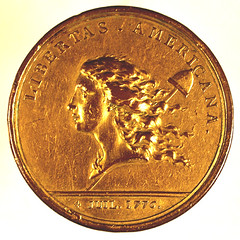 When the founders of the American Republic declared independence from Great Britain on July 4, 1776, one of the major tasks they took on was the creation of a coinage for the new nation. Finding suitable bullion, setting a monetary system, and establishing sufficient minting capability were daunting issues, to be sure, but ones that governments had dealt with for millennia. On the other hand, the republican form of government chosen for the new nation placed the founders in the position of choosing specific images to represent their ideals with little in the way of precedent to guide them.
When the founders of the American Republic declared independence from Great Britain on July 4, 1776, one of the major tasks they took on was the creation of a coinage for the new nation. Finding suitable bullion, setting a monetary system, and establishing sufficient minting capability were daunting issues, to be sure, but ones that governments had dealt with for millennia. On the other hand, the republican form of government chosen for the new nation placed the founders in the position of choosing specific images to represent their ideals with little in the way of precedent to guide them.
The leading figures in the process of selecting the numismatic imagery of the American Republic were Benjamin Franklin, Thomas Jefferson, and George Washington, and each man's contributions reflected his background, personality, and ideals. Following a rancorous dispute between the Senate and the House of Representatives, the ultimate choice for the main image for the new coinage was "an impression emblematic of Liberty," which took the form of the head of a beautiful woman adorned with a cap derived from classical attributes of the Roman goddess Libertas. Together with the complementary attributes of an eagle and a wreath, this symbol came to exemplify the United States of America.
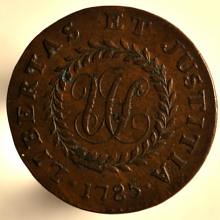
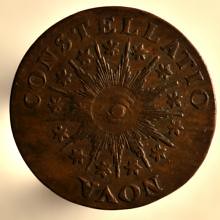
Nova Constellatio copper, 1785
Alan added:
We're going to be improving the website (especially the brightness of the images) over the next week or two. The website is instead of a published catalog -- cheaper for us and the viewers; whether it's as permanent is an open question.
Alan Weinberg noticed the dark images, too. He's his review:
On March 2 I viewed the entire Princeton numismatic website presentation. Some remarkable coins mixed with super-disappointing condition coins. Among the most impressive coins was a choice Oak Tree shilling (my mouth watered as this is one of my specialties) , the 1792 half disme, the 1794 dollar and the 1794 half dollar which must be among the finest known (deeply toned but some traces of mint lustre) and far rarer choice than the overblown 1794 dollar.
Among the most disappointing items was a modern restrike of the Washington Before Boston (what, they didn't even have one of the chocolate brown 19th century restrikes?) and a terrible condition 1793 Wreath large cent - not even a 1793 Chain cent!
And the 1792 Getz pattern copper cent is a terrible low grade electrotype. Surprisingly low grade specimens given the time period over which this collection has been formed.
Perhaps, for me, the most impressive item was the choice Unc. 1801 Reich-designed Thom. Jefferson inaugural medal in white metal. In this mint condition it is actually rarer than the silver.
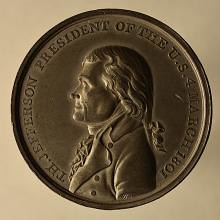
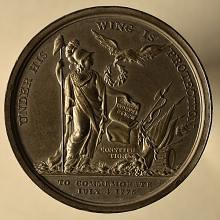
One problem permeated the entire visual presentation: photography lighting. I dunno who did the photography but clearly they paid little attention to proper item lighting. The vast majority of coins and medals are poorly lighted making visual examination, even under the website's available magnification, difficult.
But the site is definitely worthwhile viewing and perhaps some Princeton alumni will assist in upgrading the numismatic cabinet.
To visit the exhibition web site, see: rbsc.princeton.edu/capping-liberty/
To read the earlier E-Sylum article, see: CAPPING LIBERTY: NUMISMATIC ICONOGRAPHY FOR THE NEW AMERICAN REPUBLIC (www.coinbooks.org/esylum_v15n09a05.html)
NOTES FROM E-SYLUM READERS: MARCH 4, 2012
Manhattan Beach Centennial Medals
Ron Abler writes:
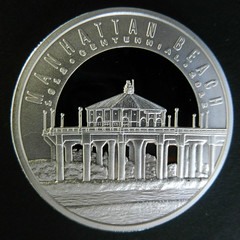 I really enjoyed the article about the Manhattan Beach Centennial medal. I grew up near there, and my father owned a pharmacy on Manhattan Beach Boulevard. I spent many carefree hours of my youth fishing off that pier. My sister still lives there, and I forwarded the ordering information to her. I don't know how you do it, but there's always at least one article that grabs me every week. Keep up the great work!
I really enjoyed the article about the Manhattan Beach Centennial medal. I grew up near there, and my father owned a pharmacy on Manhattan Beach Boulevard. I spent many carefree hours of my youth fishing off that pier. My sister still lives there, and I forwarded the ordering information to her. I don't know how you do it, but there's always at least one article that grabs me every week. Keep up the great work!
To read the earlier E-Sylum article, see: MANHATTAN BEACH CENTENNIAL MEDALS ISSUED (www.coinbooks.org/esylum_v15n09a17.html)
More on Toivo Johnson
Dave Alexander writes:
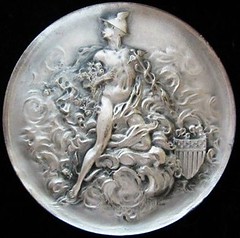 Toivo Johnson was a Finnish-American dealer of Holden, Maine. His first career flourished during the 1936 U.S. commemorative coin boom and he remained a major player in the commemorative field for decades. I exhibited his Coin Designer medals at a recent meeting of the New York Numismatic Club, where Kathy Bullowa spoke glowingly of Toivo and his early role in U.S. coins. His medals faded quickly from public perception.
Toivo Johnson was a Finnish-American dealer of Holden, Maine. His first career flourished during the 1936 U.S. commemorative coin boom and he remained a major player in the commemorative field for decades. I exhibited his Coin Designer medals at a recent meeting of the New York Numismatic Club, where Kathy Bullowa spoke glowingly of Toivo and his early role in U.S. coins. His medals faded quickly from public perception.
To read the earlier E-Sylum article, see: MEDAL SERIES PRODUCER TOIVO JOHNSON (www.coinbooks.org/esylum_v15n09a13.html)
More on Herman Steinberg
Paul Bosco writes:
I believe Herman Steinberg is familiarly known as Hi Steinberg, and was employed for a fair number of years by Hans Schulman. I think he later worked for Manfra, Tordella & Brookes, Inc (MTB).
To read the earlier E-Sylum article, see: NOTES FROM E-SYLUM READERS: FEBRUARY 26, 2012 / Hans Schulman and Herman Steinberg (www.coinbooks.org/esylum_v15n09a08.html)
More on the Osborne Company
Dave Schenkman writes:
I found the news item on Osborne interesting, although not factual. Osborne wasn't even in business in 1864, when Lincoln ran for president.
According to my notes, in 1835 Z. Bisbee established a business that, in 1848, was taken over by Ira Bisbee. In the early 1850s the company became known as Bisbee and Stanton. An 1855 directory lists Ira Bisbee and John Stanton as partners in a brand and stencil cutting business at 249 W. 5th Street. An employee, James Murdock, worked for John Stanton from 1855 to 1861, at which time he formed his own company (the names Stanton and Spencer are both well known to collectors of Civil War tokens). Murdock later purchased Stanton's business in partnership with William W. Spencer and, in 1870, he purchased Spencer's share of the business under the name James Murdock, Jr. The name was later changed to The James Murdock Jr. Company, and still later to The Murdock Stamp & Specialty Company.
The Osborne Register Company was established by Wiley Osborne in 1920. During the 1920s the company acquired the assets of the Insurance Credit System Company (formerly Ingle System Company), and also the Murdock Stamp & Specialty Company.
An Oak Ridge Irradiated Dime Card
Dick Grinolds writes:
When the irradiated coins were being discussed, mention was made of some of the coins being mounted on a card explaining the process (which was already discussed in detail). Attached is an image of one of those cards with the encased dime attached.
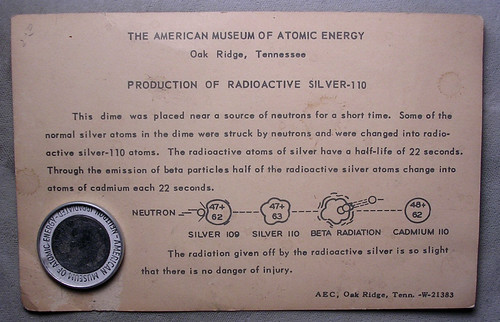
Royal Sanitary Institute Medal
Dick Grinolds writes:
In the discussion of the Bathing Absent Minded Beggar Medal, you inserted a query asking for examples of medals related to sewerage but I do not recall any published response. In any case, I humbly submit the attached medal awarded for important work in upgrading efficiency in access to the sewage system. It reads:
THE ROYAL SANITARY INSTITUTE FOUNDED 1876 / (FEMALE WITH PLATE, SNAKE WRAPPED AROUND HER ARM) / PRIZE MEDAL // AWARDED AT THE INTERNATIONAL CONGRESS &EXHIBITION ON SCHOOL HYGIENE TO J. DUCKETT & SONS, LTD. FOR "SOLENT" SCHOOL URINAL RANGE FOR THREE PERSONS, 1907 (ALL ENGRAVED).
Bronze, oval, 51mm by 40mm, harshly polished and encased in a lucite block, no signature nor edge mark.
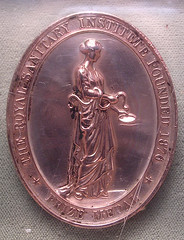

To read the earlier E-Sylum article, see: THE BATHING ABSENT MINDED BEGGAR MEDAL (/www.coinbooks.org/esylum_v15n03a13.html)
Coins From the Slot Ter Hooge
Philip Mernick writes:
The latest Elsen catalogue has some coins from a 1724 VOC wreck, the SLOT TER HOOGE. The printed catalogue has some interesting text about the contemporary salvage of the majority of the cargo by an Englishman using an early diving suit and also the modern recovery of more coins and some previously unseen bullion bars. This text does not seem to appear in their on-line catalogue.
To visit the Jean Elsen web site, see: www.elsen.be
QUERY: WHY AREN'T COMMEMORATIVE COIN SURCHARGES TAX-DEDUCTIBLE?
Anne Burke of Boston, MA writes:
The US Mint requires a "surcharge" on modern, call them, US commemorative coins. Usually the sums are $10 and $35 for the silver and gold coin respectively. The "surcharge" sum is plainly stated in the Mint brochure in fine print. This sum is not profit for the Mint but is remitted to the non-profit which is the purpose of the particular commemorative issue. Recently, for example, a commem for the Congressional Medal of Honor was issued and the "surcharge" proceeds were sent to that Foundation for education etc. I am referring, of course, to commemorative coins purchased directly from the US Mint such that a "surcharge" will be remitted by a purchaser/taxpayer to the US Mint.
Having worked as a tax preparer and although I am not an attorney nor CPA, I'm having a hard time understanding why the "surcharge" sum isn't tax deductible as a charitable deduction. Then again, Congress makes the laws.
If you are aware of any literature on this subject, please direct me further. Thank you for your courtesy.
1937 INTERNATIONAL EXHIBITION OF ARTS AND TECHNOLOGY MEDAL
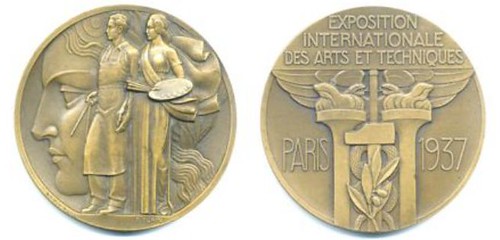
INTERNATIONAL EXHIBITION OF ARTS AND TECHNOLOGY, PARIS, 1937. CGI 3: 382B. 68mm. Bronze. Pierre Turin, Sc. (Paris Mint. Cornucopia BRONZE edgemark. Obverse with standing figures of a man and woman standing in front of a profile head of the female personification of France. The man with compasses, represents Technology, and the woman with a palette, represents Art, The inscription reads: EXPOSITION/ INTERNATIONALE/ DES ARTS ET TECHNIQUES. To either side of the torches: PARIS 1937. This is the quintessential Art Deco medal! $375.00
THE NEW YORK NUMISMATIC SCENE IN THE 1930S
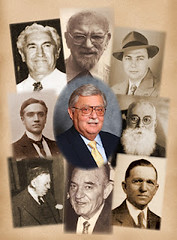 Conducting auctions from his 8-10 West 37th Street offices was veteran dealer Thomas L. Elder, a New York and national numismatic leader since he set up business in the city in 1904. Elder was as prolific an issuer of auction catalogues as he was of medals and metallic business cards. An irascible and outspoken personality, he was renowned for his verbal interchanges with other dealers, ANA leader Farran Zerbe, and even auction bidders in his own sales. He had no problem calling out that a bidder the saleroom was a 'deadbeat' if he had a long-unpaid bill.
Conducting auctions from his 8-10 West 37th Street offices was veteran dealer Thomas L. Elder, a New York and national numismatic leader since he set up business in the city in 1904. Elder was as prolific an issuer of auction catalogues as he was of medals and metallic business cards. An irascible and outspoken personality, he was renowned for his verbal interchanges with other dealers, ANA leader Farran Zerbe, and even auction bidders in his own sales. He had no problem calling out that a bidder the saleroom was a 'deadbeat' if he had a long-unpaid bill.
Elder would try to sell his business during 1933 but failed to attract a buyer. A few years later he would relocate to Pleasantville in suburban Westchester County. Ever original, Elder advertised 'Super- Vegetables, We Sell the Seed' in the April 1933 issue of The Numismatist, journal of the ANA, along with a notice of 'A Fine Bungalow in the Blue Mountains at Tryon, N.C.' which was presumably his own. The Depression was biting in for everyone.
Still at work in the city, though hard hit by the events of 1929, was Julius Guttag of Guttag Brothers, whose pioneer efforts in cataloguing Latin American coins and Hard Times tokens were a lasting legacy for future collectors. Across the city were dealers in antiques and foreign exchange who would provide material for up-and-coming younger men just making their mark in coin dealing, such as Abe Kosoff and a few years later, John J. Ford Jr.
Conducting numismatic auctions outside New York City could be found the famous paper money dealer Barney Bluestone of Syracuse, N.Y.; Arline French in Garden City, N.Y.; Norman Schultz of Salt Lake City and Charles H. Fisher of Cleveland, Ohio, conducted events large and small.
No longer active in auctions but a continuing advertiser in The Numismatist was the aged Henry Chapman of Philadelphia, whose advertisements included the proud assertion, 'I am ANA member 28.' In Orangeville, Illinois could be found the well-established M.H. Bolender, who when not conducting mail-bid sales was a schoolteacher, and in Philadelphia was William Rabin.
To read the complete article, see: Remember When: Stack's, A Numismatic Saga Part 2 (stacksbowers.com/Blogs/remember-when-stacks-numismatic-saga.html)
THE MINT AT THE MESCAL MINE: COUNTERFEITING U.S. COINS
I saw this internet article mentioned in the PGCS chatroom. Since I collect contemporary counterfeit US coinage, I followed the link and found this: http://mojavedesert.net/mining-history/mescal-mine/index.html
It is purported to be, "An article in the Los Angeles Sunday Times, December 8, 1895, by John E. Bennett, U.S. Secret Service Bureau"
It reads a bit like fiction to me, but perhaps it really did come from the LA Times (I did not confirm this).
It takes a little while to read, but I found it quite worthwhile. Here is the PCGS chatroom thread where I saw the link originally: http://forums.collectors.com/messageview.cfm?catid=26&threadid=848617
CONTEMPORARY COUNTERFEITS OF SEATED LIBERTY COINAGE
My first introduction to contemporary counterfeits was with the purchase of Gobrecht Journal Collective Volume Two. This book overflowed with information from the most knowledgeable minds in numismatics. While pouring over the pages and absorbing as much information as possible, upon reaching page 112, I found an article relating to a counterfeit 1842 dime that was crude in nature and struck from completely hand cut dies. I was instantly fascinated by this phony yet intriguing coin. Below is an example of the aforementioned 1842 contemporary counterfeit from my collection.
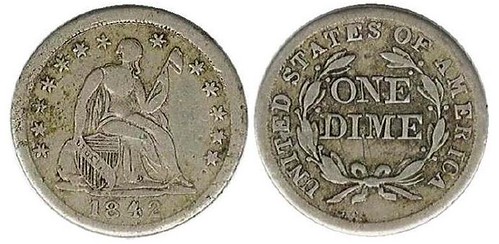
For the last few years I have been researching 19th century newspapers for news accounts of counterfeit coins. Soon afterward I realized that the manufacture of contemporary counterfeits was a much more common crime than I previously realized. Many interesting newspaper articles and stories exist that detail the "art" of making small denomination coinage.
Counterfeits were generally produced by one of two methods. The first was the "cast counterfeit" method, which was basically making a mold of a genuine coin from plaster of Paris, clay and sometimes copper then using molten metal (lead, pot metal etc) to produce a "coin" from that mold. Here is an example of a more sophisticated mold made of copper, along with a fake 1861 quarter that would have been produced from it. Notice the upper loop of the 8 in the date is filled; this is caused by trapped air bubbles in the mold transfer process. These random little "blobs" are telltale signs of a cast coin.
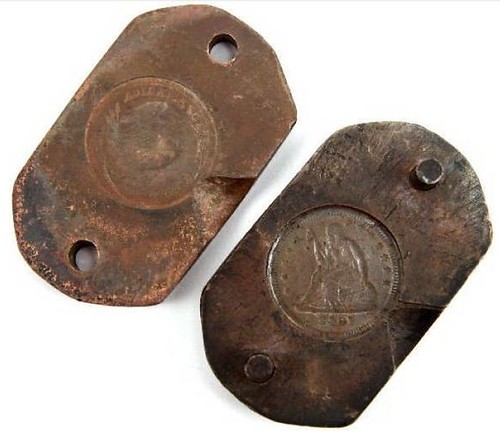
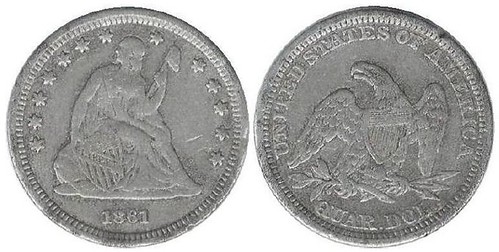
For more information on the Liberty Seated Collectors Club, see: www.lsccweb.org
ARTICLE EXPLORES THREAT OF DOLLAR COIN COUNTERFEITING
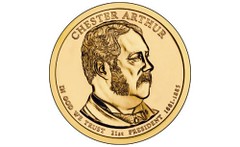 Last year over 1 billion unwanted dollar coins were languishing in Fed vaults; polls found that, as long as $1 bills were still being made, most people preferred them instead. Undeterred by the coin's unpopularity-or by the slow fade of coin and paper currency alike in an increasingly cashless era-several weeks ago Senators John McCain (R-AZ) and Tom Harkin (D-IA) announced support for the COINS Act, a new bill that would phase out $1 bills over the next four years in favor of $1 coins. It's an ambitious plan, but there's a hidden catch: Adopting $1 coins may leave a half-billion-dollar hole in our pocket-from counterfeiting.
Last year over 1 billion unwanted dollar coins were languishing in Fed vaults; polls found that, as long as $1 bills were still being made, most people preferred them instead. Undeterred by the coin's unpopularity-or by the slow fade of coin and paper currency alike in an increasingly cashless era-several weeks ago Senators John McCain (R-AZ) and Tom Harkin (D-IA) announced support for the COINS Act, a new bill that would phase out $1 bills over the next four years in favor of $1 coins. It's an ambitious plan, but there's a hidden catch: Adopting $1 coins may leave a half-billion-dollar hole in our pocket-from counterfeiting.
If counterfeit coins sound like a problem more suited to the Arthur administration, tell that to the Europeans. The same week as McCain and Harkin announced their support of the bill, the European Commission Anti-Fraud Office released its latest report on fake coins. Their European Technical and Science Centre intercepted 157,000 bogus euro coins in 2011. The report's year-to-year figures reveal that faked 50-cent and 1-euro coins, worth about 66 cents and $1.32 respectively, have been steadily increasing in number for the last four years.
Coin counterfeiting lives on as a low-tech and low-risk crime with steady returns through bulk sales to criminals and laundering via crooked storeowners and even through slot machines. In the last decade, most major coinages have been faked, including British pounds, Russian rubles, Indian rupees, Japanese yen, and Canadian dollars.
Although they seize thousands of fake coins every year, both Europe and Canada have kept counterfeiting rates relatively low by actively sorting and keeping track of fakes, and then responding with countermeasures. The 1 and 2 Euro pieces have a bull's-eye-style bimetallic composition-an invention that dates back to the Romans, but that can still deter amateurs-while this year, Canada issued new $1 and $2 coins with laser-marks and electromagnetic signatures meant to deter counterfeiters.
Other countries have not fared so well-and the U.K., in particular, offers a cautionary tale. The British pound is an old-fashioned gold-colored coin with a bewildering number of variant designs. In other words, it's rather like a U.S. dollar coin, if far more subtly colored and pleasingly weighty. In the early 1990s, Brits began noticing shabbily engraved and suspiciously light currency jangling their pockets; bartenders found lagers paid for with quids so soft that you could dent them on the edge of the bar.
In Edinburgh's rougher pubs, the going rate for a bag of 1,000 coins was £180, while in Northern Ireland paramilitary gangs were said to be getting in on the action. One counterfeiter alone, sentenced in 2007, was found to have struck 14 million pieces; another gang, as police were closing in, dumped 13,000 coins into the River Thames. They could afford the loss: Their mint had turned a profit of about £450,000 on an initial setup cost of £10,800.
But could coin counterfeiting happen here? Incredibly, we don't even know if it already has. The Secret Service is in charge of dealing with counterfeit currency; but after making Freedom of Information Act inquiries with them when the $1 presidential coin program was in full swing, I found their countermeasures appeared to be ... nothing at all . And unlike the authorities in Europe or Canada, the Secret Service has issued no reports of assaying $1 coins or looking for counterfeits. (This despite the fact that in 2003, the Secret Service announced busts in Colombia of operations creating fake Sacagawea dollars.)
The U.S. Mint website doesn't even mention the possibility of fake modern circulating coinage, nor does it give instructions on how to detect them. Then again, with 25 different $1 coin designs already in circulation-the Susan B. Anthony, four Sacagawea variants, and the first 20 presidents-the $1 coin's identity has been so diluted that few would know a real from a fake anymore. Could you pick James K. Polk out of a lineup?
At least one agency has taken notice of the problem inherent in proposals like the COINS Act, though: the General Accounting Office. "Senior officials at the Federal Reserve and Mint told us the increased circulation of $1 coins could increase the risk of counterfeiting," noted a GAO report last spring. Their analysis-which was otherwise rather favorable to the coin option-noted that the United States was far less prepared for such counterfeiting than other nations: "Both Canada and the U.K. created validation programs. ... The Federal Reserve banks circulate coins they receive from commercial banks, but do not have a comparable validation program."
To read the complete article, see:
Do You Know What James K. Polk Looks Like?
(www.slate.com/articles/business/cashless_society/2012/02/
the_chester_a_arthur_1_coin_and_the_scary_threat
_of_coin_counterfeiting_.single.html)

A LIBERTY SEATED QUARTER COIN GLASS SAUCE DISH
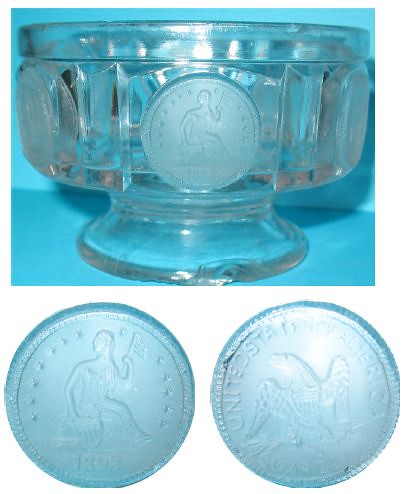
Even though we are well past the "accumulation phase" of life, I am always searching for something numismatic or ML Beistle related and she has (many!) other interests including old glass. She called my attention to a beautiful very old pickle jar in a glass case. I didn't see the old jar because, in front of it, was a beautiful example of an 1892 dated Liberty Seated quarter dollar sauce dish coin glass.
For many years, I've been searching, without success, for examples of Liberty Seated coin glass, that is, glass with the Liberty Seated design. I've known about them from articles in other publications but just couldn't find any. I've seen examples of a common design that looks like coins but is actually a pseudo coin. I've seen articles where various collectors and dealers had massive coin glass collections and always wanted at least one example for my personal collection.
An internet "Google" search of coin glass turns up many hits including some good background information on coin glass, one of the best being www.oldandsold.com/articles/article246.shtml .
In summary, this type coin glass was made by Central Glass Company of Wheeling, West Virginia in 1892 possibly for a few reasons: "The Chicago Exposition which, in addition to commemorating the discovery of America, was also honoring the 100th anniversary of the Mint in Philadelphia. Secondly, "free silver" had been advocated by "Coin" Harvey in the Western States, and William Jennings Bryan was using it as a political platform at the moment."
In any case, "five months of actual production took place before the Treasury Department moved in and declared that the process was actually counterfeiting. A Federal law had been violated in the practice of reproducing actual coins. The moulds were destroyed. This stopped the production of the "coin glass" pattern and left but a very limited amount of genuine "coin glass" in the hands of scattered dealers and unsuspecting owners."
For more information on the Liberty Seated Collectors Club, see: www.lsccweb.org
FLEA MARKET FIND STORY: CONTINENTAL DOLLAR IN PEWTER
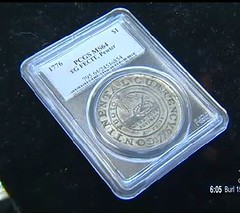 He carried a treasure in his pocket for 40 years but had no idea. A Vermont man's find at a flea market four decades ago turned out to be a windfall.
He carried a treasure in his pocket for 40 years but had no idea. A Vermont man's find at a flea market four decades ago turned out to be a windfall.
Salisbury resident and amateur coin-collector Garry Cucci recently decided to sell his lucky coin to pay off some credit cards. Turns out, the coin is luckier than he imagined.
Last year, the United States minted nearly half a billion coins, but Gucci's coin is technically from the first batch of U.S. coins ever made.
"I'm amazed I never lost it," he said.
The New Jersey transplant bought the coin at a flea market in 1969. "Paid a buck for it and I thought that was a good deal," he explained with a laugh.
John K. Martin Jr. Runs a coin shop in South Burlington. "I've seen hundreds of copies and this one was different," he said.
Cucci wanted his "lucky token" appraised; so he brought the coin to Martin hoping to get enough money to pay off a credit card or two.
"We're working on getting pricing for the coin and it should bring well over $100,000," said Martin, "I don't think the economy will affect this coin just because it's so rare."
To read the complete article, see: Lucky charm holds hidden value (www.wcax.com/story/17041824/lucky-charm-holds-hidden-value)
THE COLLECTION OF W.W.C. WILSON
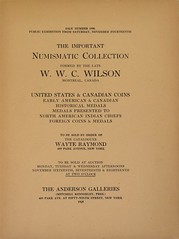

RAYMOND, Wayte. THE IMPORTANT NUMISMATIC COLLECTION FORMED BY THE LATE W. W. C. WILSON, MONTREAL, CANADA. UNITED STATES & CANADIAN COINS, EARLY AMERICAN & CANADIAN HISTORICAL MEDALS, MEDALS PRESENTED TO NORTH AMERICAN INDIAN CHIEFS, FOREIGN COINS & MEDALS.
New York, NY: Anderson Galleries, Sale Number 1996, November 16-18, 1925
92pp, 1,260 lots, 3 halftone plates
Quarto: 25.5 x 21 cm
Softbound: Tan card covers
Sale catalogue is available without the three halftone plates.
Gengerke (9): DpP
Adams: 9
To read the complete article, see: THE COLLECTION OF WWC WILSON (wiki.coinbooks.org/index.php/THE_COLLECTION_OF_WWC_WILSON)
TEDXLEEDS2012: ALTERNATIVE MONEY CONFERENCE
At TEDxLeeds2012, we'll be showcasing the most interesting ideas about the future of money and promise that any stories of stockbrokers, building societies, accountants, call centres or bankers will be challenging and provocative!
Humanity has begun to see money as a natural force - like air or gravity - speaking of "market forces" as if they exist outside human agency, yet the constructs and cultures of money are entirely of human invention...and consequently anything we invent, we can innovate and enhance. Wall Street's "unnovation" of money - thousands of little algorithms... volatile, unpredictable, and impossible for humans to comprehend - brought us a global financial singularity, which still threatens to form a black hole...
However, there are others that are innovating new futures for money - as tools for localism, as exchanges for creative skills and as anti-corruption mechanisms. We're going to take you on a tour of people currently remixing the meaning of money. Leeds is a city of inventors and TEDxLeeds will return Leeds to its role as an innovator of money.
But this won't be simply be about talking heads. TEDxLeeds is about activism, and we intend to demonstrate some of the ideas being discussed...
a basic clothes swap
the creation of a local currency (a Leeds Pound? the Holbuck? the Jimmy? the Loiner? the Ludos?) which will exist for just the evening of 29th February!
To read the complete article, see: TEDXLEEDS2012: MONEY TALKS (www.tedxleeds.com/tedx2012/)
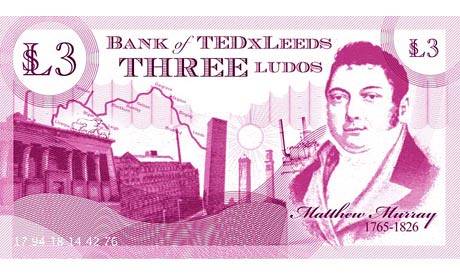
Here's joyful news for all children of Leeds: we are about to get our very own banknotes.
Not for long admittedly, but on Wednesday at the city's noble Corn Exchange you will be able to use the pink 3 Ludo and blue 5 Ludo notes within a closed economy at a conference on the future of money.
Tired of the long-standing pound versus euro debate, the organisers of TEDxLeeds, a homely Leodiensian version of global blue-sky thinking conferences in California on 'Ideas worth spreading', have printed a stack of Ludos. The work of local freelance web designer Tom Morgan, they were named by Emma Bearman of the city's excellent CultureVulture blog.
The big pink man on the 3 Ludo is Matthew Murray, an engineer on a level with James Watt who was commercially out-manoeuvred by the latter. One of the great mysteries of my life is why my great-grandfather Richard, an exuberant entrepreneur who claimed to have invented a smokeless chimney, commissioned the statue of Watt which stands in City Square.
To read the complete article, see:
Leeds gets its very own banknotes as alternative money summit meets
(www.guardian.co.uk/uk/the-northerner/2012/feb/27/leeds
-money-banknotes-ludos)
THE BOOK BAZARRE
BANK OF ENGLAND'S LOW-SERIAL NUMBER BANKNOTES
Tradition has it that when the Bank launches a new banknote, the chancellor of the exchequer receives the one with the serial number 11 (numbers one, two and three go to the Queen, the Duke of Edinburgh and the prime minister respectively - none of whom, you might think, need the money).
To read the complete article, see:
Mervyn King gives chancellor a bit of investment advice
(www.guardian.co.uk/business/economics-blog/2012/mar/
01/mervyn-king-chancellor-advice-sme)
THE 1933 DOUBLE EAGLE WORLD TOUR OPENS IN LONDON
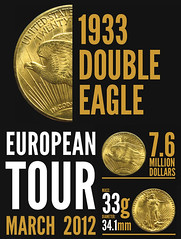 Within the splendor that is the Goldsmith's Hall, among the priceless paintings and abundant city-of-London history, the display of the legendary 1933 Saint Gaudens Double Eagle gold coin made a bit of history itself today. On loan by special permission from the Smithsonian Institution and in conjunction with the Samler Huset Group, sponsors of the event, the coin will feature on a multi-city tour to what is expected will be many thousands of interested coin enthusiasts and collectors who will relish the opportunity to see an item which would ordinarily be off limits unless a visit to the US capitol is on the horizon.
Within the splendor that is the Goldsmith's Hall, among the priceless paintings and abundant city-of-London history, the display of the legendary 1933 Saint Gaudens Double Eagle gold coin made a bit of history itself today. On loan by special permission from the Smithsonian Institution and in conjunction with the Samler Huset Group, sponsors of the event, the coin will feature on a multi-city tour to what is expected will be many thousands of interested coin enthusiasts and collectors who will relish the opportunity to see an item which would ordinarily be off limits unless a visit to the US capitol is on the horizon.
With the kind of fanfare and anticipation usually on show for rock stars or royalty, the famed 1933 St. Gaudens $20 gold double Eagle coin was unveiled to a roomful of news reporters, journalists and photographers. Often referred to as the world's most expensive coin, amid the security, from local, national and right up to international level, the glittering and renowned gold coin was unveiled from under red drapery by Peter Swanston, Samler Huset's CEO.
Commenting on the event, Mr. Swanston noted "This is an incredibly exciting event. As well as being immensely valuable, the 1933 Double Eagle is a truly beautiful coin. We are thrilled to bring it to London and I'm sure many people will want to come and see this icon of American history."

Encased in a Lucite frame and now housed in a glass and black steel showcase, which will also serve as its secure home for the next few weeks, the gold coin traveled from its permanent home in Washington D.C. to the heart of the financial district in London, literally a stone's throw from the iconic St. Paul's Cathedral.
The American numismatic treasure will be on show from the 3rd to the 4th March, just two days in London as it makes its way through several European capitals. I have it on good authority that the next city which will have the opportunity to welcome the coin will be Dublin. The tour organizers tell me that anyone wishing to know where to see the coin after Dublin will have to follow its progress on Facebook and Twitter due to the security concerns. The links appear below.
www.facebook.com/1933DoubleEagleTour
https://twitter.com/#!/1933DoubleEagle
This Museum example currently on tour has spent almost its entire life as part of the National Numismatic Collection of the United States and on display at the world renowned Smithsonian Institution. Under the supervision and careful eye of Richard Doty, Senior Curator and Karen Lee, project Specialist of the Smithsonian, both are accompanying the coin as it winds its way through several European capitals in this the first tour of its kind. It was my privilege to have had the opportunity to inspect the coin close up and as a dedicated collector for most of my life, it was a great privilege.
Wondering why anyone would be willing to foot the bill for such an expensive undertaking, I looked up The Samler Huset Group. It's a Norwegian-owned, international mail order company selling collectibles such as coins, medals, stamps and banknotes.
By the way, Dr. Doty was also recently awarded the Huntington Medal for 2011 by the American Numismatic Society. Congratulations! Have a great trip. -Editor
To read the complete article, see: 1933 Double Eagle Gold Coin Begins European Tour (news.coinupdate.com/double-eagle-gold-coin-begins-european-tour-1250/)
LIBERIA'S DUAL CURRENCY SITUATION
Liberia has two kinds of currency that circulate simultaneously in that North African country, their own Liberian coins and paper money plus those of the United States, and occasionally those of Great Britain.
The financial gurus of the country met recently to discuss having exclusive, all Liberian, native coins and currency. Guess what was on the table at that discussion? Answer:: Krause Publications' Standard Catalogue of World Coins.
A report of that meeting was published this week. The planning for the elimination of a dual currency situation has some interesting numismatic aspects, in addition to the international financial considerations.
Mention was made of the dozens of Liberian commemorative coins -- apparently which even native Liberians are unaware -- as past Liberian coins. Should some of the denominations of those commemorative coins be a part of any new Liberian coinage system?
If you would like to explore more on this topic, click on:
Juggling with Liberia's Dual Currency Regime
(www.liberianobserver.com/index.php/business/item/628-
juggling-with-liberia%E2%80%99s-dual-currency-regime)
'STAR-SPANGLED BANNER' COINS IN CHOCOLATE
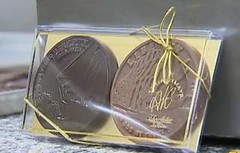 The folks at A. Kirchmayr Chocolatier in Timonium make chocolate into art and mark important events in a delicious way. Now, they've been commissioned to be a part of the 200th anniversary of the War of 1812 by creating commemorative chocolate coins.
The folks at A. Kirchmayr Chocolatier in Timonium make chocolate into art and mark important events in a delicious way. Now, they've been commissioned to be a part of the 200th anniversary of the War of 1812 by creating commemorative chocolate coins.
"We wanted to put some gold dust or silver dust on it, but it came out so nicely that we just left mild and dark chocolate that it basically represents the gold and silver," said chocolatier Albert Kirchmayr.
The chocolate coins are exact replicas of the gold and silver versions of the 2012 Star-Spangled Banner commemorative coins which will be released by the U.S. Mint for a limited time. They will go on sale starting with the kickoff event on March 5 at Fort McHenry through December 2012.
"They honor 'The Star-Spangled Banner,'" said Jill Feinberg with Star-Spangled 200. "There's an image of the flag, there's an image of Francis Scott Key's words, 'Oh say, can you see.' They're very patriotic images."
Feinberg said the silver coin will retail for about $50 and the gold coin will be market priced weekly.
After the March 5 event, you can get a pair of the chocolate coins for $8. Part of the proceeds will go back into the Star Spangled 200 fund.
"It will go towards events and programming such as Star-Spangled Sailabration, educational outreach and to maintain the legacy of 1812 sites all around Maryland," said Feinberg.
You can support the cause by purchasing either version of the coin. The chocolate ones can be mementos to keep or a sweet treat to share.

To read the complete article, see: Local Chocolatier Commemorates 'Star-Spangled Banner' (www.wbaltv.com/news/30552339/detail.html)
FEATURED WEB PAGE: COINING TECHNOLOGY HERITAGE
This week's Featured Web Page is suggested by Dan freidus, who writes:The Segovia Mint has a nice page on 16th-18th century European mint technology. They have photos from, and links to, a variety of museums with relevant items

www.segoviamint.org/cth.htm
